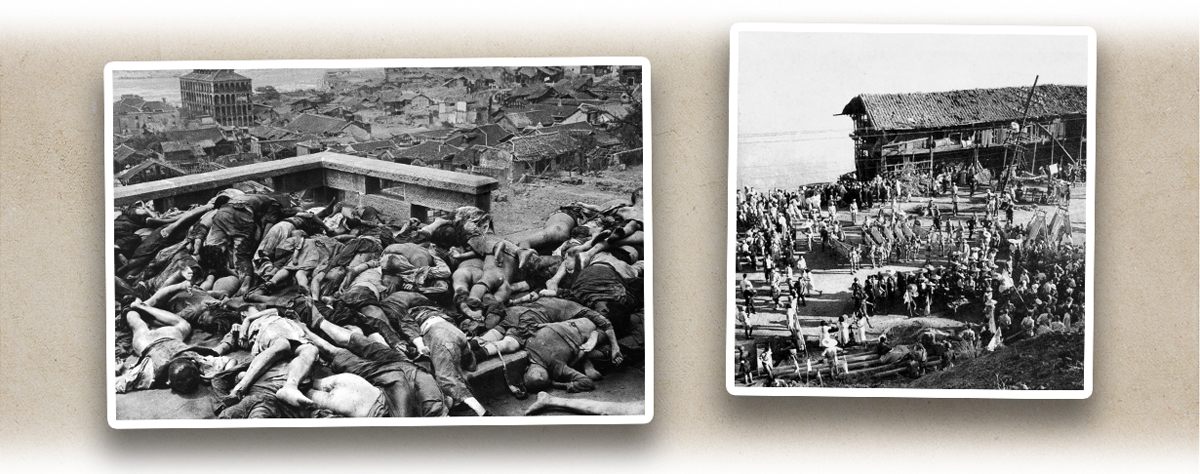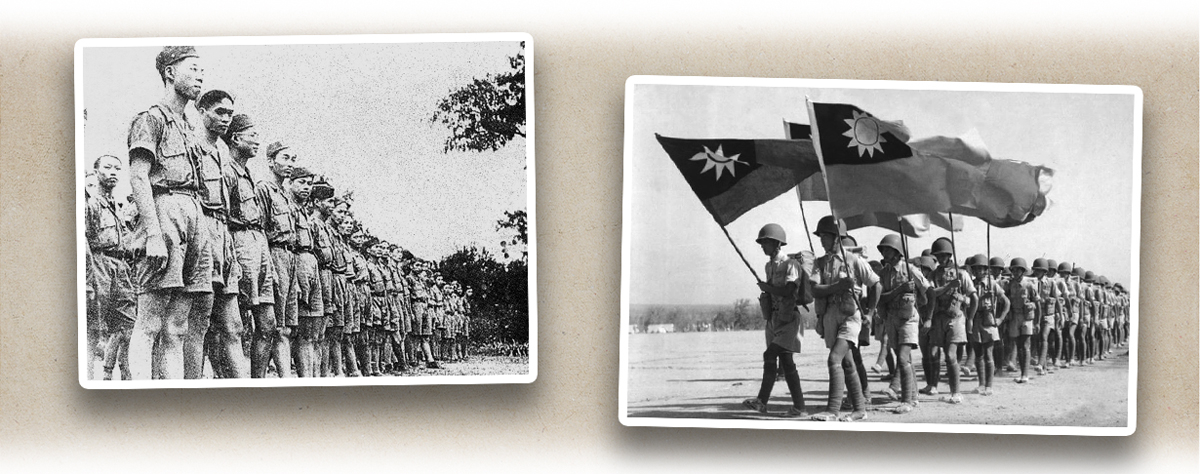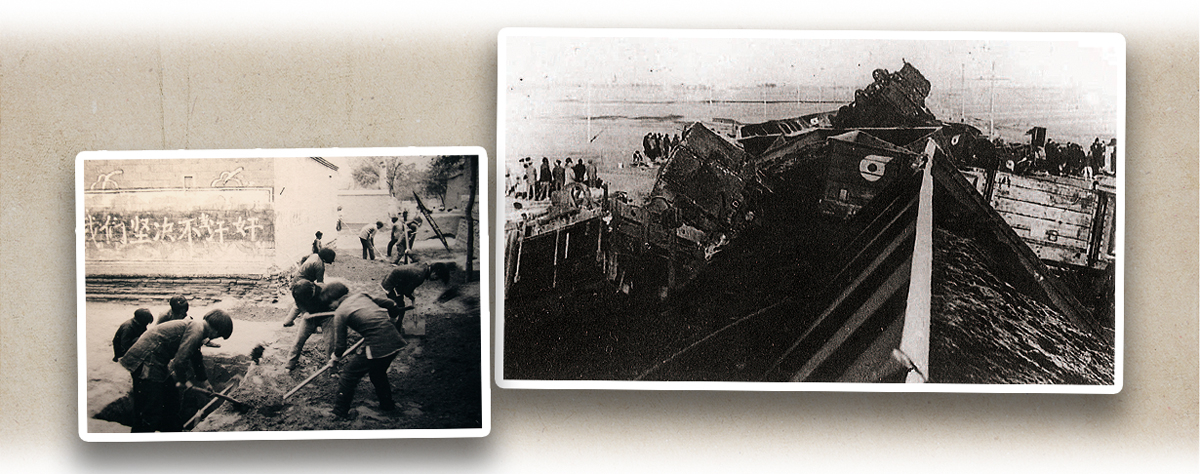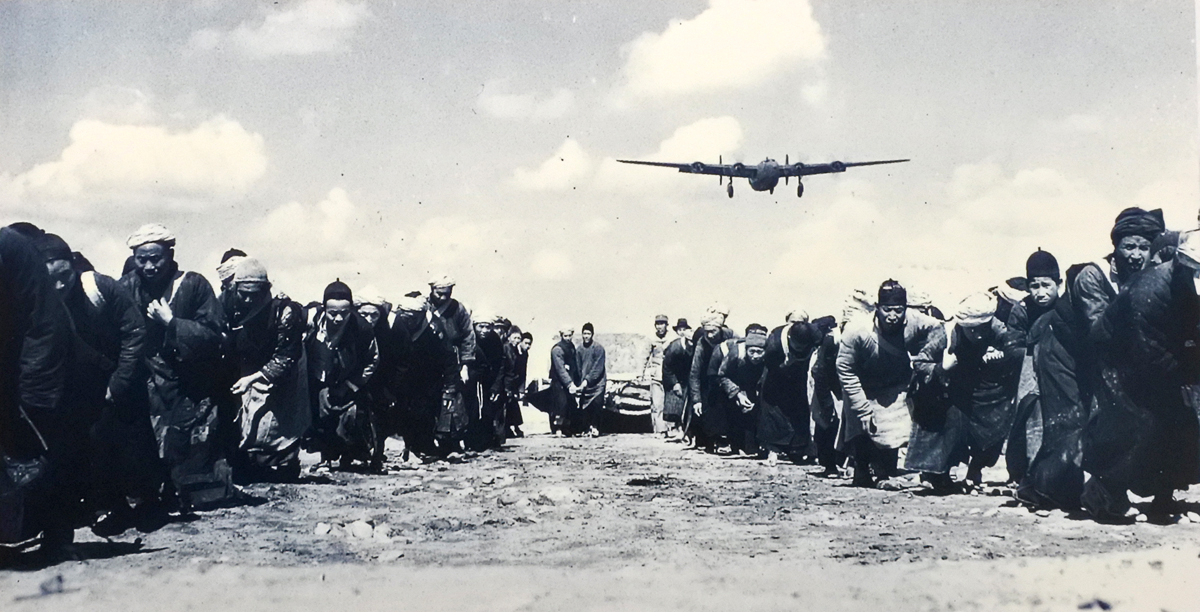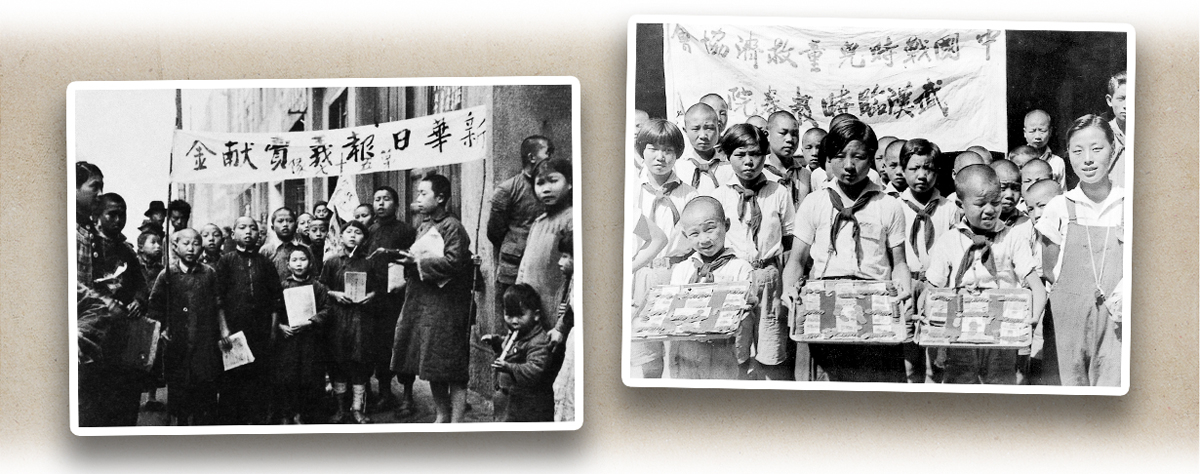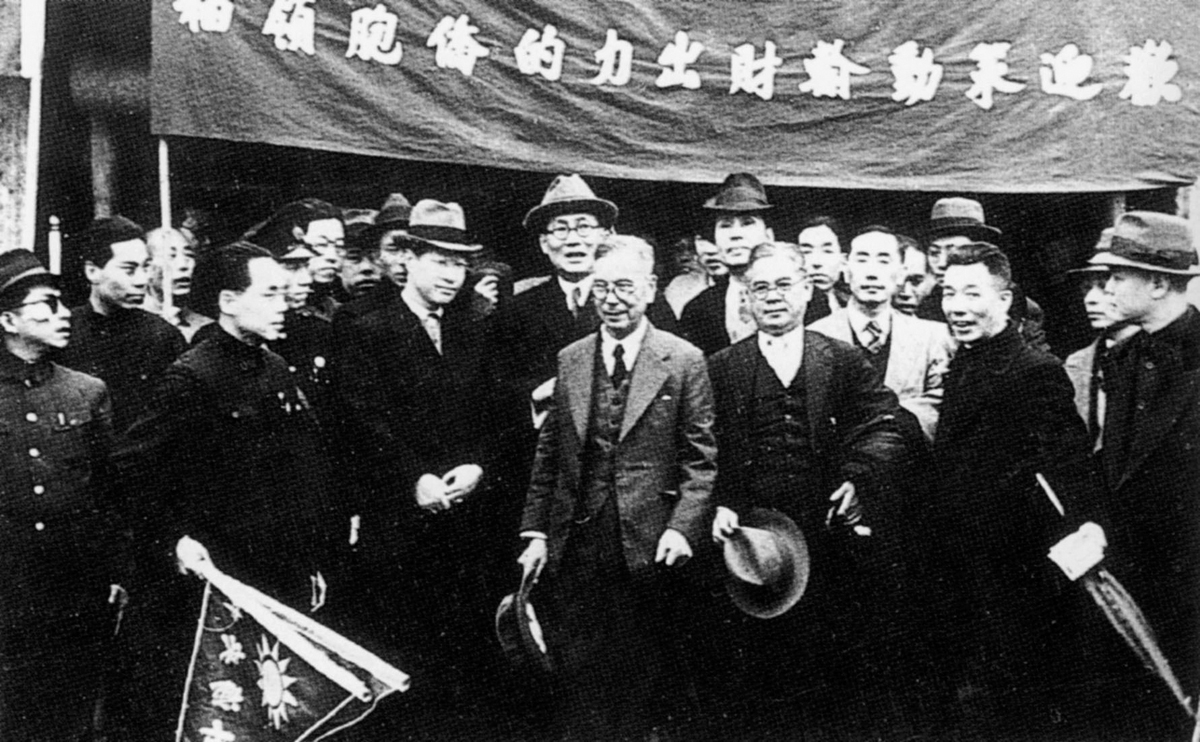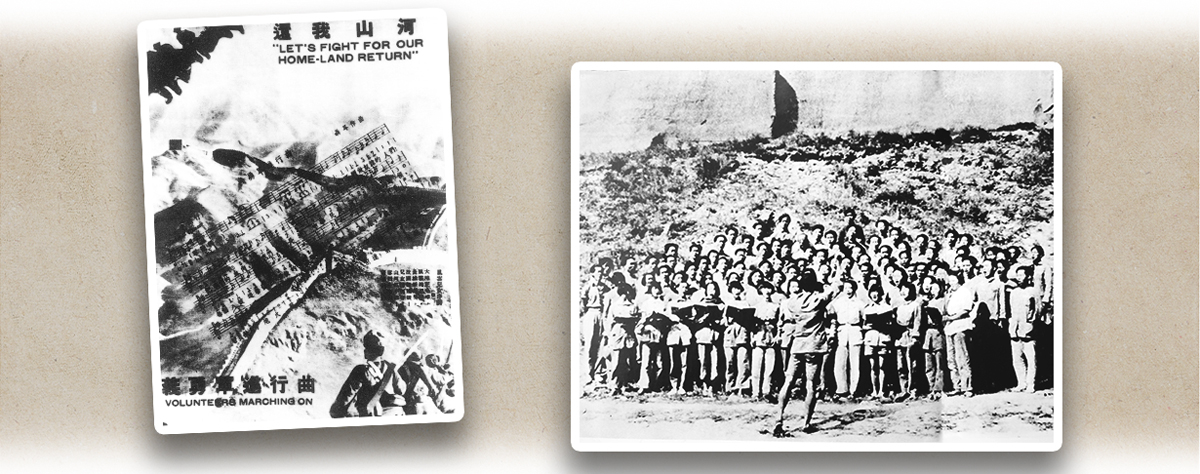China lost over half of its territory to Japan since the outbreak of the Total War of Resistance, including north, east, central, and most parts in south China. The government made Chongqing (重慶) its temporary capital and established a rear area in the southwest. Although the whole country, especially Chongqing, was being heavily bombarded by the Japanese Air Force, the Chinese people rose against the enemy. Numerous youth joined the army on the front line and war songs, such as March of the Volunteers (also known as Volunteers Marching On) and Yellow River Cantata, could be heard nationwide. Soldiers and civilians conducted tunnel fights in the enemy’s rear area. Armed work teams and railway guerrillas were also formed.
Compatriots in Hong Kong and Macao and overseas Chinese also contributed to the resistance against Japan. In 1938, Soong Ching-ling (宋慶齡) founded the China Defence League in Hong Kong. Civilians from Mainland China took refuge in Hong Kong and the city took them in with open arms and raised funds for the war. Macao was a neutral territory but its people made generous contributions and formed over 30 relief societies to support the war. Thousands of overseas Chinese also supported the motherland in desperate salvation and more than half of the eight million overseas Chinese donated money. During the Eight Years’ Total War of Resistance, their donations exceeded 1.3 billion yuan (in the currency of the Republican era). Tan Kah Kee (陳嘉庚), a community leader of overseas Chinese in Southeast Asia, advocated that only traitors would attempt to negotiate with the Japanese before its withdrawal from Chinese territory, which manifested his strong resolution to resist.
|
|
Why was the War of Resistance an important phase in Chinese music history? Are there any war songs that still circulating today? |
|
|
See answer below. |
During the war, the Nationalist government moved westward to Chongqing and made the city its temporary capital. The Japanese air bombed the city many times, killing an incalculable number of civilians, but the people remained strong-willed. Left: Japanese planes bombarded Chongqing on the night of 5 June 1941. Civilians swarmed Jiaochangkou Tunnel (較場口大隧道) air-raid shelter, resulting in 151 wounded and 992 tragically died of suffocation. Right: air-raid wardens, scouts, Red Cross staff, stretcher parties, and other forces working in concert after the bombings.
During the five and a half years from 18 February 1938 to 23 August 1943, Japan conducted strategic bombings on the Chinese temporary capital of Chongqing. According to available statistics, Japan bombarded Chongqing over 200 times with more than 11,500 bombs in 9,000 flights. The bombings killed more than 10,000 people and destroyed over 10,000 buildings, leaving most of the downtown areas shattered. The Japanese intended to undermine Chinese morale by the mass killing of civilians. Therefore, the air raids were conducted indiscriminately on the front line and China’s rear area, targeting residential and commercial areas instead of military facilities. However, the Chinese people’s resolution to resist never wavered.
Members of the youth army in training. In October 1944, Chiang Kai-shek (蔣介石) called upon educated youth to volunteer for military service, rallying with the slogan “An inch of blood for an inch of territory, a hundred thousand youth for a hundred thousand troops.” The call received an enthusiastic response.
Soldiers and civilians alike fought the Japanese in the enemy’s rear area in North China. Left: women in central Hebei Province (河北) digging tunnels for guerrilla soldiers to use in tunnel warfare. Right: railway guerrillas blowing Japanese trains on South Shandong Railway (魯南鐵道) .
Workers building airport runway. Without road rollers and other engineering vehicles, the workers could only flatten the runways by pulling heavy stone rollers over them, which was incredibly hard work. The airports, roads, and other strategic infrastructure built by Chinese workers were crucial in the War of Resistance.
Children participating in charity sales to fund the war.
Hong Kong and Macao offered unreserved support for the War of Resistance. Left: the venue of a charity sale. Soong Ching-ling organised charity sales in Hong Kong before Japan invaded the city. Right: local industrial and commercial groups formed Macao All Circles Disaster Relief Society to support national resistance.
Overseas Chinese were eager to enlist in the army. The photo shows the Overseas Chinese Volunteer Army. Moreover, three-quarters of the pilots in China’s air force were overseas Chinese.
In March 1940, overseas Chinese in Southeast Asia returned following Tan Kah Kee (fourth from the right in the front row), bringing supplies to Chinese soldiers. They received a warm welcome in Chongqing.
After the war broke out, overseas Chinese in the United States holding a fundraising event for their motherland in Chinatown, New York.
Left: war anthem March of the Volunteers. Right: in April 1939, Xian Xinghai (冼星海) conducting a rehearsal of Yellow River Cantata in Yan’an (延安), the headquarters of the Central Committee of the Chinese Communist Party (中國共產黨). March of the Volunteers and Yellow River Cantata have since then been sung by generations.
|
|
Why was the War of Resistance an important phase in Chinese music history? Are there any war songs that still circulating today? |
|
|
China is a country of poetry and “Poems express aspirations” is a long-held belief. It is said that poets were born out of rage and that songs are created by heart. In the 14 years of War of Resistance, a group of artists and writers emerged on the front line and in the enemy’s rear area. Their great works uplifted the spirit of the Chinese nation and have since become enduring calls to battle. As a result, modern Chinese music made progress during this period, despite the state of war, and a number of songs created back then are still popular today. The following are some of the best-known ones: Along the Songhua River by Zhang Hanhui (張寒暉) is part of the Exile Trilogy (together with two pieces created by Liu Xue’an ﹝劉雪庵﹞). It tells the story of the tragedies in Northeast China as the area fell into Japanese hands. The Sword March by Mai Xin ( 麥新) tells the story of the Defence of the Great Wall and the broadsworded defenders of the Marco Polo Bridge. March of the Volunteers composed by Nie Er (聶耳) with lyrics by Tian Han (田漢) is the theme song of the film Children of Troubled Times released in April 1935. It is about how the sons and daughters of the Chinese nation united in solidarity with an unyielding spirit in their resistance against Japanese invaders. March of the Volunteers is now the national anthem of the People’s Republic of China. Yellow River Cantata composed by Xian Xinghai with lyrics by Guang Weiran (光未然) is another masterpiece held dear by the Chinese people. Guerrillas’ Song was written by He Luting (賀綠汀), an upbeat and catchy tune inspired numerous railway guerrillas. Another classic is Unity is Strength, just to mention a few. |
Source of most photos used in this feature piece: Fotoe and misc. photo sources.





